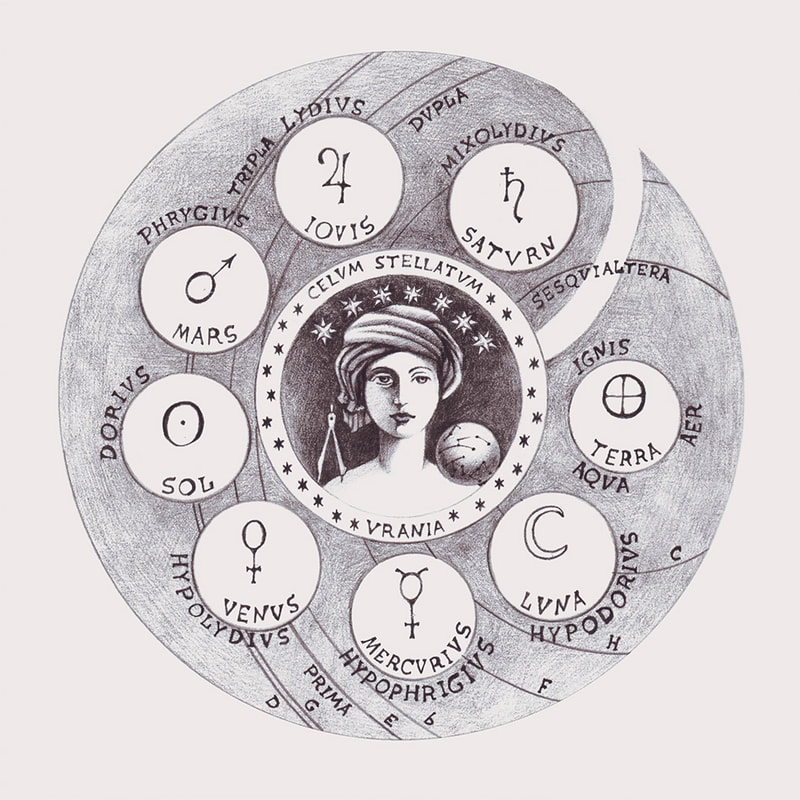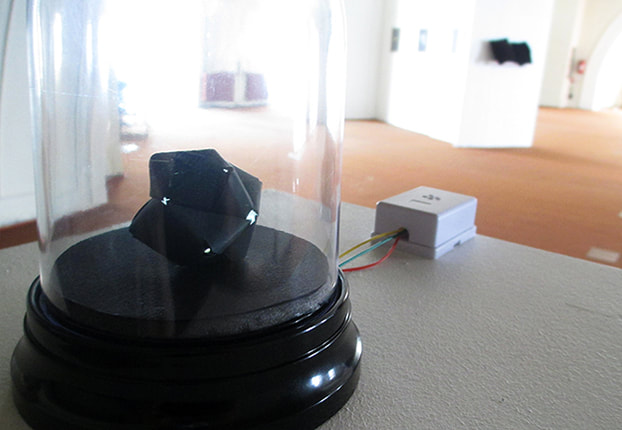Earlier projects
Oiwa, Artenion, and Tagetes constellation boxes - collaboration with RSM
"Planetario: Observaciones Estelares Especulativas." 2014. Y Gallery, Tartu, Estonia.
In this series we invent new constellations or reshape existed ones and ponder the shape we ascribe to the Universe. By using the box as a basis for each artwork we offer an opportunity to conceive of the Universe as having a cubic shape. As the constellation is purely speculative and the way stars are united in one assemblage is purely conventional, there is always a possibility to reassemble them from a different point of view. Being the result of Western thought, a traditional system of constellation designations resorts to Greek mythology and uses names of animals, thereby concealing other possibilities of naming. Against this background, we offer new constellations and naming them after a plant (Tagetes), a character from Japanese folklore (Oiwa), and a fictional character, allegedly created by Ovid (Artenion). Each acrylic box is decorated with a personalization of the constellation we invent and is filled with smd LEDs that function as starts. The boxes are accompanied by a pseudo-scientific map of skies with invented and real, or conventional constellations.
"Planetario: Observaciones Estelares Especulativas." 2014. Y Gallery, Tartu, Estonia.
In this series we invent new constellations or reshape existed ones and ponder the shape we ascribe to the Universe. By using the box as a basis for each artwork we offer an opportunity to conceive of the Universe as having a cubic shape. As the constellation is purely speculative and the way stars are united in one assemblage is purely conventional, there is always a possibility to reassemble them from a different point of view. Being the result of Western thought, a traditional system of constellation designations resorts to Greek mythology and uses names of animals, thereby concealing other possibilities of naming. Against this background, we offer new constellations and naming them after a plant (Tagetes), a character from Japanese folklore (Oiwa), and a fictional character, allegedly created by Ovid (Artenion). Each acrylic box is decorated with a personalization of the constellation we invent and is filled with smd LEDs that function as starts. The boxes are accompanied by a pseudo-scientific map of skies with invented and real, or conventional constellations.
Coelvm Stellatvm - collaboration with RSM
Site-specific intervention, fractal monotype on paper, mounted on architectural soffit, 338.5" by 18.7" (8.6m by 47.5cm)
"Planetario: Observaciones Estelares Especulativas." 2014. Y Gallery, Tartu, Estonia.
In the XVI-XVII centuries, Coelum Stellatum was supposed to be the limit of the world beyond which nothing exists and which is the final step in man’s movement, absolute knowledge gained in pure contemplation, and the first step in God’s movement, that is, leaving off the state of Divine Nothingness, or Deus abscondidus. The idea behind the project is realized in the depiction of Coelum Stellatum in a series of fractal monotype decorated with existing and the invented constellations and fixed onto a frieze of the doom featured by the temporary space of Y Gallery, as well as by a small drawing “Urania“, the muse that presides over astronomy.
Site-specific intervention, fractal monotype on paper, mounted on architectural soffit, 338.5" by 18.7" (8.6m by 47.5cm)
"Planetario: Observaciones Estelares Especulativas." 2014. Y Gallery, Tartu, Estonia.
In the XVI-XVII centuries, Coelum Stellatum was supposed to be the limit of the world beyond which nothing exists and which is the final step in man’s movement, absolute knowledge gained in pure contemplation, and the first step in God’s movement, that is, leaving off the state of Divine Nothingness, or Deus abscondidus. The idea behind the project is realized in the depiction of Coelum Stellatum in a series of fractal monotype decorated with existing and the invented constellations and fixed onto a frieze of the doom featured by the temporary space of Y Gallery, as well as by a small drawing “Urania“, the muse that presides over astronomy.
Dorado/Lacerta tähtkujud (constellations) - collaboration with RSM
Conductive paint on paper and electronics, 93.6" by 33.1" (2.3 m by 84.1 cm).
2014, Science Centre AHHAA, Tartu, Estonia.
“Dorado/Lacerta” is an inquiry into the organicity and interactivity of electronics by means of the use of capacitive conductive ink. Conductive ink might perceive the proximity and touch of a user and respond, for example, with light or sound. The project creates a big-scale visual installation that would enable users to interact directly with the paper and trigger lights (emitted through smd LEDs). The installation will results in generation of a more organic experience with technology, thereby bridging a gap between technology and the organic realm.
The visual aspect of the installation combines patterns that imitate organic forms of nature with those that follow invented (inorganic) forms of cultural traditions. The overall pattern fills the paper through different variations and with the addition of smd LED lights. As the project is intended to interact with the audience in a major scale, the work is 0,6 m of height and 1,8 m of width; it issuspended against a wall through clips. Smd LEDs are placed to create two constellations, namely Dorado and Lacerta. In addition, a group of 7 sensors, which have been made separately and situated on each side of the main pattern, switch on the constellations or their parts upon touch. In the project, I am responsible for a visual (graphic) realization of the idea.
Conductive paint on paper and electronics, 93.6" by 33.1" (2.3 m by 84.1 cm).
2014, Science Centre AHHAA, Tartu, Estonia.
“Dorado/Lacerta” is an inquiry into the organicity and interactivity of electronics by means of the use of capacitive conductive ink. Conductive ink might perceive the proximity and touch of a user and respond, for example, with light or sound. The project creates a big-scale visual installation that would enable users to interact directly with the paper and trigger lights (emitted through smd LEDs). The installation will results in generation of a more organic experience with technology, thereby bridging a gap between technology and the organic realm.
The visual aspect of the installation combines patterns that imitate organic forms of nature with those that follow invented (inorganic) forms of cultural traditions. The overall pattern fills the paper through different variations and with the addition of smd LED lights. As the project is intended to interact with the audience in a major scale, the work is 0,6 m of height and 1,8 m of width; it issuspended against a wall through clips. Smd LEDs are placed to create two constellations, namely Dorado and Lacerta. In addition, a group of 7 sensors, which have been made separately and situated on each side of the main pattern, switch on the constellations or their parts upon touch. In the project, I am responsible for a visual (graphic) realization of the idea.
















